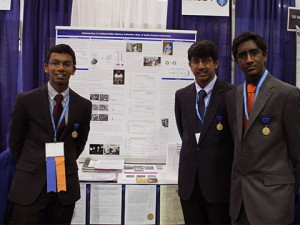
Only 18% of all college engineering majors are women. Google’s leadership is 79% male. We’ve heard these stats countless times as corporations, educational institutions, and government leaders surge to increase the number of women in STEM. So many initiatives are convinced that the key is to get girls interested in science early, but there are also huge challenges in keeping women in STEM during college and throughout their careers.
THE MYTH OF HARDWIRED ABILITY SETS IN GENDER
Some claim that bias against women in STEM is a thing of the past and that the gender imbalance is simply due to an innate difference in ability. There have been numerous studies claiming to prove that men are innately better at spatial reasoning and math, whereas women excel at empathy.
Psychologist Cordelia Fine critically debunks these claims in Delusions of Gender, where she highlights the poor scientific practices of these studies and how cultural assumptions affect our abilities. She outlines the little we know about MRI analysis, the unacceptably small sample sizes of data, and spread of blatant misinformation. One study used self-reported evaluations to show that women are more empathetic, but when testing actual ability, like determining an emotion based off a facial expression, women and men performed at the same level.
So, if it isn’t a difference in ability that is the issue, what is the problem? Well, simply being exposed to stereotypes and cultural assumptions can make you act in accordance with them. Fine describes a study where some subjects were told that women perform worse on a math test due to genetics and others were told that men and women have no innate differences in ability. In the group that was told the gender bias, women performed significantly worse, whereas in the other group, men and women performed equally well. This was no isolated occurrence either; these results have been replicated in more than 300 studies. Even subtle indicators, such as checking off your gender or race before a test, can affect your performance by subconsciously making yourself more aware of stereotypes.
The belief that men are genetically more capable of performing well in STEM is incredibly pernicious. I am exposed to gender stereotypes implicitly when I only see headlines with white male leaders of technology companies, when my teachers encourage me to go into education instead, and when I am constantly questioned over why I want to be an engineer while my male peers are rarely asked.
I am exposed to them explicitly when I read about a new study that suggests women’s “wiring” makes them less capable in mathematics, and even during a talk at Yale when a female leader in 3D printing technology claimed that women have poorer spatial reasoning skills.
Although we are women in science, we are certainly not immune to internalizing gender stereotypes and insecurities, especially when garnished with the scientific jargon we are so used to trusting.
THE DANGER IN VIEWING INTELLIGENCE AS INNATE
The idea of innate abilities is not constrained to the context of gender; we perpetuate this concept daily. Do we think hard enough about the effect of phrases like, “You’re so smart”? We give some of them “talented and gifted” labels, but as they grow older, we find that some of our most high achieving in elementary school hit a growth ceiling. In using such language, we praise when achievements come easily and naturally; “struggle” becomes like a dirty word: an indication of stupidity, a source of shame.
Carol Dweck, a psychologist at Stanford University, conducted a study comparing students with either the belief that intelligence can change with effort or that intelligence is fixed. Those who believed intelligence is fixed were more likely to avoid challenges, easily give up, view effort as fruitless, disregard feedback, and feel threatened by the success of others. In contrast, those with a growth mindset embrace challenges, see effort as necessary to mastery, learn from criticism, and find inspiration in the success of others.
The underscoring of intelligence and abilities as innate and unchangeable is especially detrimental to retaining women in engineering fields. In grade school, many women may do well in science and math without trying too hard, but college-level courses become significantly more difficult. Women who believe that men are innately more equipped for STEM fields are more likely to give up when enrolled in challenging STEM courses, even when they are not performing worse than their male peers. In facing a difficult course, women also experience stereotype threat, i.e. anxiety over confirming a negative stereotype, which may not only make them perform worse but also encourage them to drop out of STEM more easily.
THE EFFECT OF GENDER STEREOTYPES ON SELF-ASSESSMENT AND STANDARDS OF SUCCESS
Exposure to stereotypes also affects our standards and self-perception, influencing what careers we see as viable. When our performance level is ambiguous, we tend to subconsciously rely on stereotypes to gauge success. Shelley Correll, a sociologist at Stanford, conducted a study in 2004 that used a test with no right answers and measured a fictitious skill area, contrast-sensitivity ability. One group was told that men performed better at this skill, while the other group was told there was no gender difference. After the test, all subjects were given the same score. In the group exposed to gender bias, women had a lower self-assessment of their abilities and higher standards for what score would indicate high ability. In the other group, average self-assessment rating and standards of high performance were equal.
The same phenomenon occurs in the sciences, as women have been shown to believe that success in STEM requires exceptionally high standards. Higher standards for success, underestimation of ability, and a fixed intelligence mindset make it unfortunately common for women to consider leaving STEM fields when faced with challenges.
INITIATIVES FOR CHANGE: ARE WE DOING ENOUGH?
There are a multitude of institutions working to increase women’s engagement in STEM, ranging from the White House to Google to local grassroots organizations. The National Girls Collaborative Project brings together STEM organizations focused on women to come up with data-driven activities that have been shown to increase young girls’ engagement in STEM. Activities emphasize the problem-solving aspect of STEM so that when faced with challenging courses later, girls are not intimidated and embrace struggle as a necessary component of innovation. However, its program mostly uses informal educational programs outside of class, which limits its effect and the number of girls it reaches.
Google started Made With Code, an initiative to encourage young girls to learn about programming. The videos help combat the stereotype of the white geeky male by featuring female role models in STEM and a variety of other professions. However, the projects leave much to be desired. “Accessorizer” simply edits selfies with graphics, “Gif” makes an animation with long eyelashed cartoons, and “Bracelet” makes a 3D printed bracelet that is sent to you. Adorned with pink and purple, the website sends the message that if girls are involved in technology, it has to be feminized, cute, and easy. There is not an explanation on how a 3D printer works or any actual coding. Reading what they tell you to drag and drop is the most stimuli a user will get.
Missing from Google’s project is any sort of dynamic view of gender. Girls can enjoy more than selfies and cute bracelets – they can also be interested in science, sports, and building. Problem-solving and struggle are at the heart of any STEM career, and it’s completely missing from this site.
Most initiatives for engaging women in science are outside of school activities, often excluding many girls from their reach. Another common complaint is that they do not focus enough on gender equity, preventing educators and young women from recognizing and correcting outside and internalized gender bias.
RADICAL RESULTS REQUIRES RADICAL CHANGE
The lack of women pursuing STEM education is not an isolated issue; it is a symptom of the way our society thinks about gender and intelligence. While focusing on increasing and keeping women in STEM courses is important, successful women with STEM degrees will still face discrimination in the workplace. A 2004 study by psychologist Madeline Heilman showed that women were more likely to be viewed as less competent in “masculine” fields when their performance was not explicitly recorded, but when women were irrefutably shown to be successful, they were often rated as less likable than a man of the same skill level and personality. For women, it is a challenge to be seen as both competent and likable in STEM fields, making it difficult to advance their careers. The lack of paid maternity leave is yet another issue women in STEM struggle with. While it is important to help women achieve success in their STEM education, ignoring larger issues of gender equity will not help women who face prejudice and hostility in the workplace.
Sustained change and progress will require a fundamental shift towards viewing gender more fluidly in the context of social constructions rather than as a source of biologically absolute characteristics. In breaking down the idea of inevitable skill sets and traits based on gender, we can dismantle stereotypes. Intelligence should be presented as malleable and unfixed, a result of hard work and overcoming challenges. As educators, parents, or peers, we can all work towards helping ourselves and those around us to defeat restrictive societal assumptions.
INITIATIVES TO TAKE AS EDUCATORS
- Emphasize that success is a result of effort, not fixed ability
- Praise effort and problem-solving
- Combat the shame of struggling by emphasizing challenges as a necessary part of learning and growth
- Introduce students to female engineers and scientists to combat stereotypes and present role models
- Have a clear discussion with your class about gender biases, reaffirm that their abilities are not determined by their gender but by hard work and motivation
Sources
“Diversity at Google.” Diversity. Google, 2014. Web. 30 June 2014.
Fine, Cordelia. Delusions of Gender: How Our Minds, Society, and Neurosexism Create Difference. New York: W. W. Norton, 2010. Print.
Hill, Catherine, Christianne Corbett, and Andresse St. Rose. “Why So Few? Women in Science, Technology, Engineering and Mathematics.” AAUW. American Association of University Women, 2010. Web. 30 June 2014.
“The State of Girls and Women in STEM.” National Girls Collaborative Project. National Girls Collaborative Project, June 2013. Web. 30 June 2014.







